NCERT Solutions for Class 9 Science Chapter 6 Tissues provides detailed answers for all in-text and exercise Questions. These solutions contain an in-depth explanation of each topic involved in the chapter. Students studying in class 9 can access these solutions for free in PDF format.
All these solutions are prepared by expert teachers and updated for the current academic session. NCERT Solutions for Class 9 Science Chapter 6 Tissues help students to understand the fundamental concepts given in class 9 Science textbook. We have prepared the answers to all the questions in an easy and well-structured manner. It helps students to grasp the chapter easily.
NCERT Class 9 Science Chapter 6 Tissues Intext Questions (Solved)
PAGE NO. 61
Question 1: What is a tissue?
Answer: A tissue is a group of similar cells that work together to perform a specific function in an organism.
Question 2: What is the utility of tissues in multi-cellular organisms?
Answer: In multi-cellular organisms, tissues serve the important purpose of organizing the body into different specialized groups of cells, each with specific functions. This organization allows the organism to carry out complex activities efficiently. For example, muscle tissue helps in movement, nervous tissue aids in transmitting signals, and vascular tissue in plants transports water and nutrients. By having different tissues for different tasks, multi-cellular organisms can maintain their structure, protect themselves, and adapt to their environment, making them more efficient and versatile than single-celled organisms.
PAGE NO. 65
Question 1: Name types of simple tissues.
Answer: Simple permanent tissues are of three types: Parenchyma, Collenchyma, and Sclerenchyma. Parenchyma tissue is of two types – aerenchyma and chlorenchyma.
Question 2: Where is apical meristem found?
Answer: Apical meristem is present at the growing tips of stems and roots. Their main function is to initiate growth in new cells of seedlings, at the tip of roots, and shoots.
Question 3: Which tissue makes up the husk of coconut?
Answer: The husk of a coconut is made up of sclerenchyma tissue.
Question 4: What are the constituents of phloem?
Answer: Phloem is the food conducting tissue in plants. It is made up of four components:
- Sieve tubes
- Companion cells
- Phloem parenchyma
- Phloem fibres
PAGE NO. 69
Question 1: Name the tissue responsible for movement in our body.
Answer: The muscular tissue is responsible for movement in our body.
Question 2: What does a neuron look like?
Answer: A neuron consists of a cell body with a nucleus and cytoplasm. It has two important extensions known as the axon and dendrites. An axon is a long threadlike extension of nerve cells that transmits impulses away from the cell body. Dendrites, on the other hand, are thread-like extensions of cell body that receive nerve impulses. Thus, the axon transmits impulses away from the cell body, whereas the dendrite receives nerve impulses. This coordinated function helps in transmitting impulses very quickly.
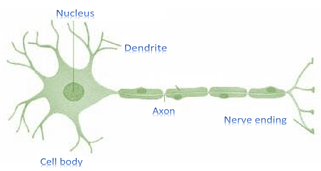
Question 3: Give three features of cardiac muscles.
Answer: Three features of cardiac muscles are:
- Cardiac muscles are involuntary muscles that contract rapidly but do not get fatigued.
- The cells of cardiac muscles are cylindrical, branched, and uninucleated.
- They control the contraction and relaxation of the heart.
Question 4: What are the functions of areolar tissue?
Answer: Functions of areolar tissue:
- It helps in supporting internal organs.
- It helps in repairing the tissues of the skin and muscles
CBSE Class 9 Science Tissues Exercise Questions and Answers
Question 1: Define the term ‘tissue’?
Answer: The group of cells similar in structure that work together to achieve a particular function forms a tissue. This group of cells has a common origin.
Question 2: How many types of elements together make up the xylem tissue? Name them.
Answer: Xylem is a complex tissue. It is made up of following four kinds of cellsor elements:
- Tracheids
- Vessels
- Xylem parenchyma
- Xylem fibres.
Question 3: How are simple tissues different from complex tissues in plants?
Answer: Simple tissues are made up of one type of cells which coordinate to perform a common function.
Complex tissues are made up of more than one type of cells. All these coordinate to perform a common function.
Question 4: Differentiate between parenchyma, collenchyma and sclerenchyma on the basis of their cell wall.
Answer: The differences between cell walls of parenchyma, collenchyma and sclerenchyma are given in the following table:
| Parenchyma | Collenchyma | Sclerenchyma |
| Cell wall is primary | Cell wall is primary. | Cell wall is secondary. |
| Cells have thin walls and made up of cellulose. | Cell walls are thickened at the corners due to protein deposition. | Cell wall is very thick due to lignin deposit |
Question 5: What are the functions of Stomata?
Answer: The small pores present in the epidermis of the leaf are stomata. Stomata are enclosed by two kidney shaped cells called guard cells.Functions of Stomata
- Exchange of gases, particularly CO2 and O2, with the atmosphere.
- Loss of water in the form of vapour during transpiration.
Question 6: Diagrammatically show the difference between the three types of muscle fibres.
Answer:
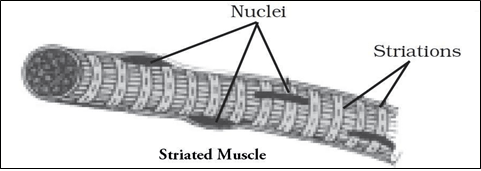
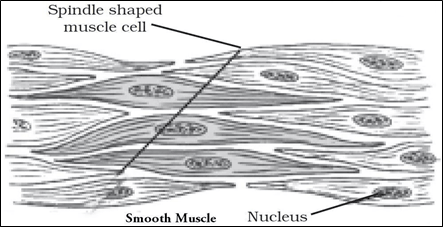
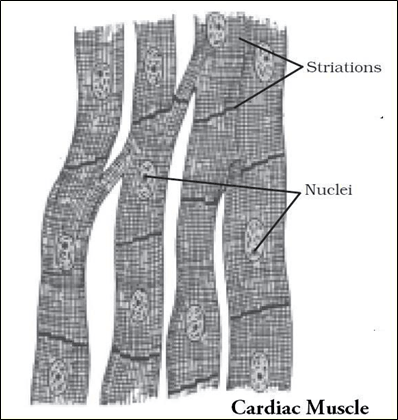
Question 7: What is the specific function of cardiac muscle?
Answer: Cardiac muscles are involuntary muscles which show characteristics of both smooth and striated muscles. These muscles occur in the walls of the heart.
Functions of Cardiac Muscles:
- Cardiac muscles contract and relax rapidly, rhythmically and tirelessly throughout life. They contract endlessly from early embryonic stage until death.
- The contraction and relaxation of heart muscles help to pump and distribute blood to various parts of body.
Question 8: Differentiate between striated, unstriated and cardiac muscles on the basis of their structure and site / location in the body.
Answer: Striated, Unstriated and Cardiac muscles are three types of muscle tissues. Their different characteristics are as follows:
| Character | Striated Muscles | Unstriated Muscles | Cardiac Muscles |
| 1. Shape of cells | Cells are long cylindrical, non-tapering and unbranched | Cells are long with tapering ends (spindle shape) and unbranched. | Cells are non-tapering, cylindrical and branched. |
| 2. Nucleus | Many nuclei (multinucleated) which are situated towards the periphery of muscle fibre. | The cells have only one nucleus (uni-nucleated) situated in the center. | Each cell contains one or two nuclei situated in the center. |
| 3. Striation | Transverse alternate light and dark bands present. | Striations or strips are absent. | Cells have faint striations. |
| 4. Mode of Contraction | Voluntary contract rapidly but soon undergo fatigue. | Involuntarily not at our will. Contract comparatively slow but do not fatigue. | Involuntary, rhythmically contract and relax throughout life without fatigue under normal conditions. |
| 5. Example of location | Hands, legs and other skeletal muscles. | Stomach wall, intestine, ureter, bronchi etc. | Present in heart. |
Question 9: Draw a labelled diagram of neuron.
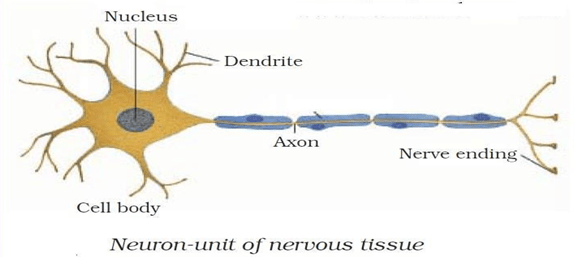
Question 10. Name the following.
(a) Tissue that forms the inner lining of our mouth.
(b) Tissue that connects muscle to bone in humans.
(c) Tissue that transports food in plants.
(d) Tissue that stores fat in our body.
(e) Connective tissue with a fluid matrix.
(f) Tissue present in the brain.
Answer:
(a) Squamous epithelium
(b) Tendon
(c) Phloem
(d) Adipose tissue
(e) Blood
(f) Nervous tissue.
Question 11. Identify the type of tissue in the following:
Skin, bark of tree, bone, lining of kidney tubule, vascular bundle.
Answer:
Skin: Striated squamous epithelial tissue
Bark of tree: Protective tissue and cork
Bone: Connective tissue
Lining of kidney tubule: Cuboidal epithelial tissue
Vascular bundle: Conducting tissue(xylem and phloem). Complex permanent tissue
Question 12: Name the regions in which parenchyma tissue is present.
Answer: Parenchyma is a simple permanent tissue of angiospermic plants. It is present in cortex and pith of stem and roots. It is also present in the mesophyll of leaves. When it contains chlorophyll, it is called Chlorenchyma, found in green leaves.
Question 13: What is the role of epidermis in plants?
Answer: Epidermis is a protective tissue of angiospermic plants. It provides protection to underlying tissues. Epidermis forms outer covering of various plant organs such as roots, stem, leaves, and flowers and remains in direct contact with the environment. Any substance whether solid, liquid or gas can enter into the plant or move outside only after passing through this layer. Epidermis helps in absorption, secretion, gaseous exchange and transpiration. It helps in preventing the entry of pathogens.
Question 14: How does the cork act as a protective tissue?
Answer: The cork cells are dead cells and do not have any intercellular spaces. The cell wall of the cork cells are coated with suberin (a waxy substance). Suberin makes these cells impermeable to water and gases. Cork is protective in function; it protects underlying tissues from desiccation, infection and mechanical injury.
Question 15: Complete the table:

Answer:
